July 2012
Lapland
Northern Finland & Sweden
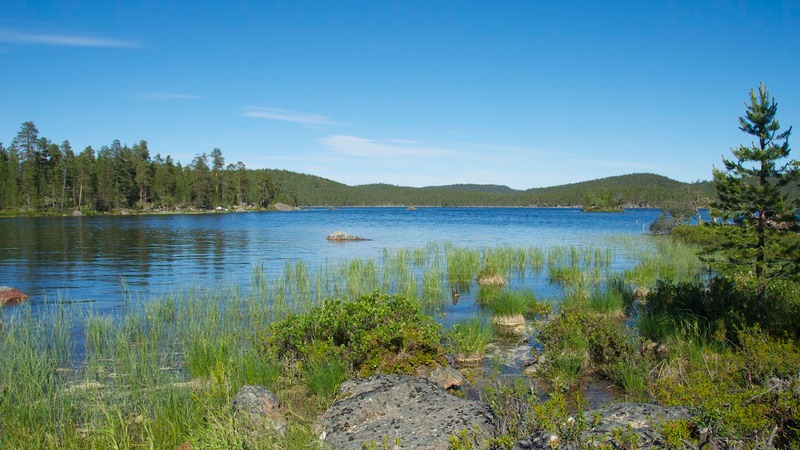
Early on in the summer, we thought we could talk about Scandinavia country by country. But in traveling through Norway, Sweden and Finland, it’s been as if each country has two separate parts: the southern and central areas, and then Lapland, which in a very general sense runs north from a bit below the Arctic Circle to the top of Europe. When we were in Norway, that natural division was quite apparent; we now find that both Sweden and Finland have that same division as well.
We’ve shared our Norwegian experiences with you already, so now let’s talk about... Lapland… The Far North… Sámi country.
Leaving Norway and crossing into Finland, we expected significant changes. Well, sure, we had to set our clocks an hour ahead of Norway, but would that be it? After all, they are right next to each other, you climb no mountain passes at the border, and both the Sámi and their reindeer are still present in large numbers.
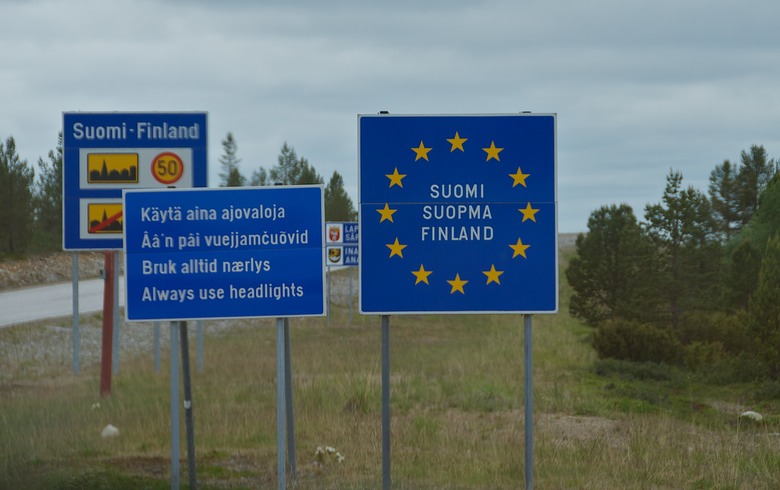
But it was different. Very quickly the landscape became flatter, there were lakes and pine forests everywhere we looked, and the reindeer were even more abundant than they had been before. Many of the small lakes had large areas of boulders along their edges; we weren’t sure why, and thought they might be glacial moraines. And, of course, the signs were all different. The Finnish language is not very much like Swedish or Norwegian; it comes from a different part of the world. So whatever little we had learned earlier in the summer just went right out the window. All the signs were in both Finnish and Sámi, neither of which was of any use to us; it just made for very large signs.
So, what about this new country? Well, we found ourselves very pleased, and liking it a lot. Norway is a tough act to follow, of course, but Finland has treasures of its own. We spent 10 days here in the northern part of the country, and will return – to southern Finland – in a few weeks.
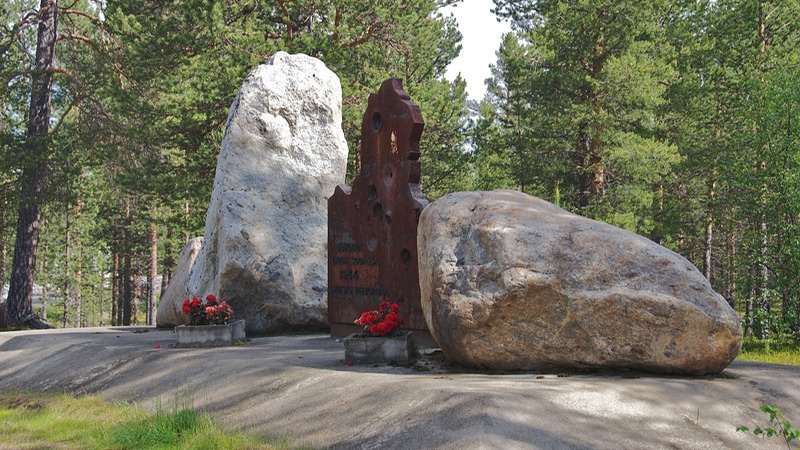
Not too far into Finland we made a brief stop at a war memorial in Kaamanen, where the World War II fighting in the north had been particularly nasty. Norway wasn’t the only country where the Germans’ retreat had taken its toll. We have learned that Finland has had a troubled history for centuries, having been dominated by one foreign entity or another for almost all of its existence. During WWII, it was squeezed between Russia and Germany, almost to the death.
Moving along, we followed E75-4 as it dropped south through Sámi country, soon stopping at Inari, home of the Finnish Sámi parliament and the tremendous Siida Sámi Museum and Nature Center. This was a terrific experience for us. The museum is beyond excellent, full of materials about the Sámi and beautifully done. We were able to learn much about this large ethnic group that inhabits parts of northern Norway, Sweden, and Finland, as well as the Kola Peninsula of Russia (all together referred to as Lapland). They are among the oldest indigenous peoples in Europe; in today’s world they number about 70,000 in total. Modern civilizaion has taken its toll, of course, but they are surviving, and have adapted very successfully; still making their living primarily from their reindeer, but adapting newer technologies along the way.
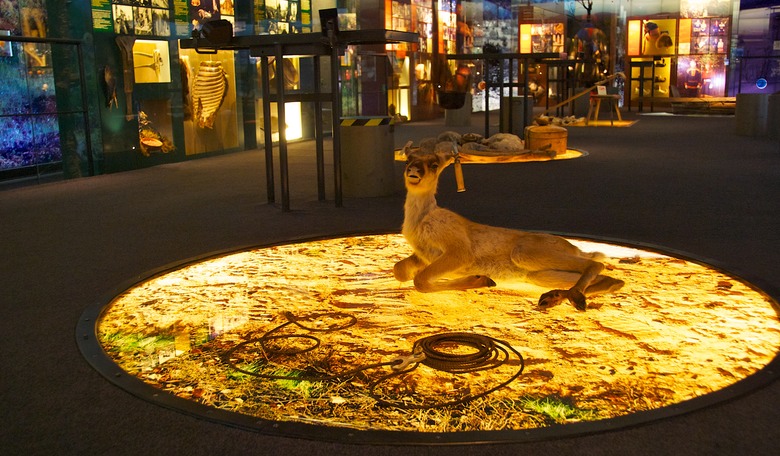
We had driven across Sámi country in northern Norway, which has several municipal museums and information panels along the roadsides. The coastal Sámi were mostly fishermen, and the coast is also where groups who lived inland brought their herds to feed during the warmer months (leaving the flies and mosquitoes behind for the tourists to enjoy); but when most of us think of the Sámi, we see them herding reindeer across the barren plains and through snowdrifts.
In Inari, in Finland, we were able to learn much more. The Sámi have their own political structure here in Finland, with their own parliament as well as representatives in the Finnish Parliament, and their headquarters are here in Inari. We visited the building, across the way from the museum. It was quite nice, newish, and had excellent facilities, including a library and a shop where you could buy really good quality handicrafts.
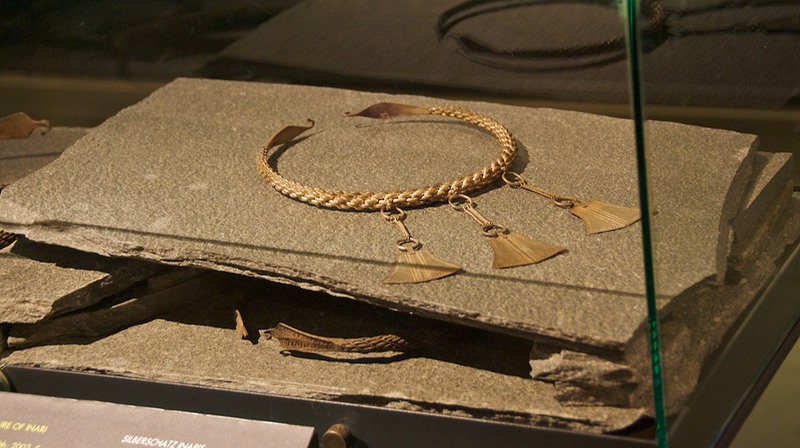
The Siida museum also provided an extraordinary opportunity to learn about life in the Arctic. There were exhibits about the climate at various times of the year, the animals, insects, just about any form of life you could imagine. Particularly interesting were discussions and displays about how an animal’s physiology changes during the year to adjust to the climate; how bears hibernate; and things like that.
The photography throughout the museum was excellent, and there also was an exhibit of paintings by a Sámi artist of the area. The paintings were of reindeer, and the works were really lovely. Outside the museum there were exhibits of Sámi homes and other buildings showing their way of life. It was a great experience for us.
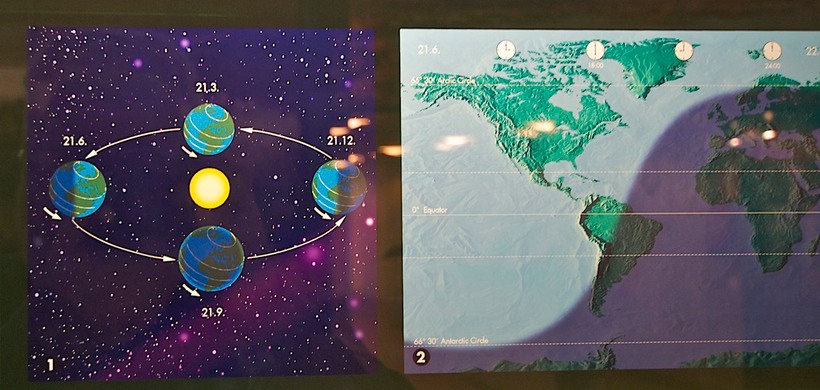
In northern Finland we had our best opportunities to enjoy the “midnight sun.” Norway has its lovely mountains, which we truly liked, but they tended to make it more difficult to follow the path of the sun in the evenings. Finland, being flatter, has more wide-open spaces. We’ve learned how to position the Tiger to take best advantage. A generally southwest angle gives us full sun on our living room side all afternoon and evening – all night long. It’s a unique feeling to wake at midnight, then again every hour or so afterwards, and note the position of the sun as it moves – pretty much horizontally – around to the point that when you awaken in the morning it has moved about 180 degrees. And there is nothing lovelier than midnight sunlight on birch trees; enchanting.
We’ve learned that above the Arctic Circle, daylight lengthens or shortens nearly an hour per week, all year long; so the changes are really noticeable. In Inari, the sun never sets for 2 full months, from May 22 to July 22; and then of course it never comes up for two full months in the winter. Try that one on for size!
By the way, we keep talking about the changeable weather in northern Scandinavia. Still true: just as likely to have rain-sunshine-clouds-sunshine-wind-rain continuing all day long here in Finland just as we have been “enjoying” for the last month or so. If you don’t like the weather, just wait 15 minutes. Overall, it’s been cloudier than we’d like, but not bad and never a problem.
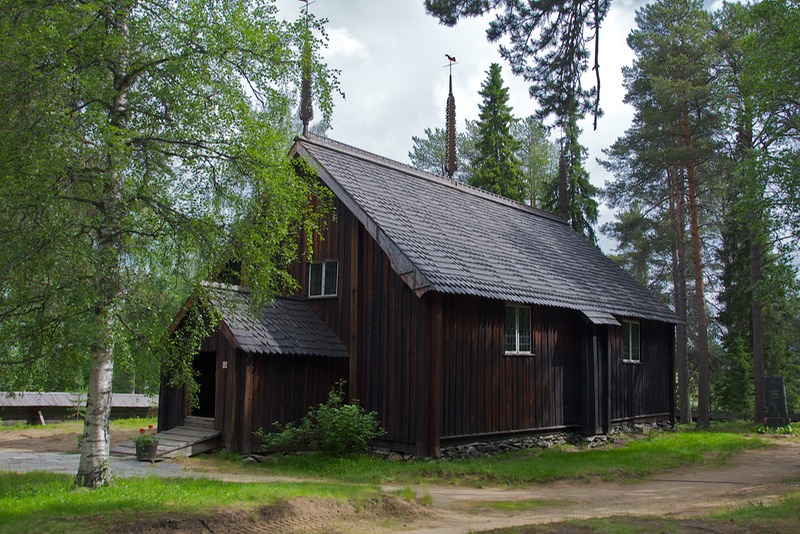
Leaving Inari we moved further south. We had a beautiful day on the road, with an explosion of flowers everywhere. We spent the night near Vuotso, parked in the grass alongside a river channel, a canal that connects two of the largest reservoirs in Europe. There is water everywhere up here. Vuotso is the site of the southernmost active Sámi settlement in Finland; we saw reindeer wandering in peoples’ yards and walking the highway through town. It was cool.
This is a big fishing area, and we stopped to buy smoked salmon (lohi) along the road – absolutely the best I’ve ever eaten. Also, for the first time since southern Sweden in early June, I was able to buy strawberries beside the road. We still were in the far north, but there were ferns beside the road, and the temperature was (often) warmer. Still no shorts, but fewer layers on top. We were quickly dropping down out of Arctic Finland.
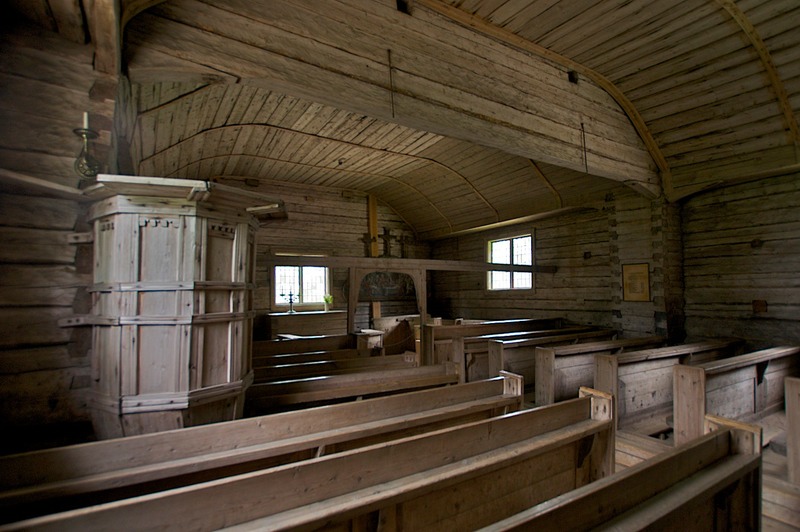
We’d been looking forward to visiting Sodankylä, and it turned out to be great. There’s a great old Sámi church there, which we enjoyed a lot. It dates back to 1689, and was built entirely of wood. We were amazed it had survived the wars, with the scorched-earth policies suffered here in the north, but apparently there had been specific orders given that this building was to be spared. We are the lucky ones, to be able to enjoy it now. It is still a consecrated church, used throughout the year. Our young guide was very helpful, and spoke beautiful English.
We had a nice chat with him; at one point I commented about how much we were enjoying each of the countries we were visiting in Scandinavia. He immediately said, “Finland is not part of Scandinavia. Our roots and language are Russian; we’re part of the European community.” This of course confused us a bit. We did know that the language and ancestry of the people in Finland were distinct from the somewhat shared heritage of Sweden, Norway and Denmark, but maps and guidebooks usually include Finland in Scandinavia… Guess we’ll have to do a little research on this.
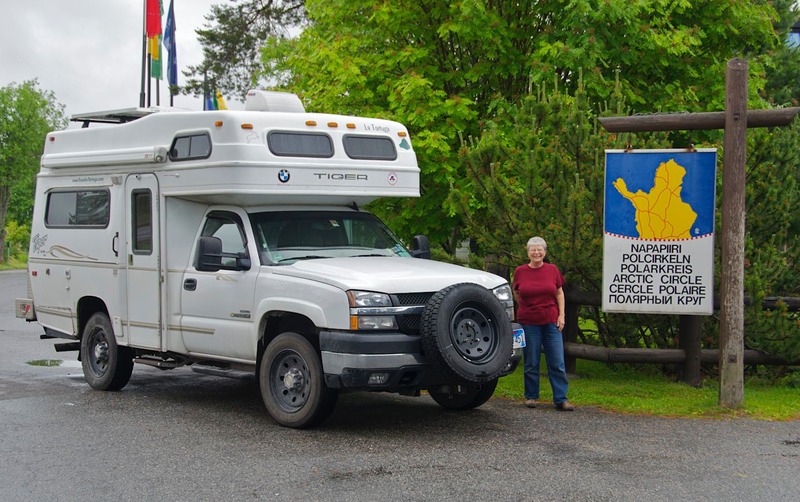
Ever moving south, we found ourselves approaching the Arctic Circle (What? Again? You betcha!), just north of Rovaniemi. The surrounding forests were healthy and lush; we made comparisons with Norway’s snowy and barren look, and Sweden’s rather scraggly trees. This was much closer to our experience in Alaska – and we reminded ourselves that Fairbanks and Rovaniemi are roughly on the same parallel.
In Finland, the Arctic Circle is “celebrated” in great (if outlandish) style – there’s a huge Santa’s Village with endless souvenir shops and a wide line through the village showing where the circle passes through. Another thing we’ve learned – never too old, you know – is that actually, the line moves through a 180 km span during a 40,000 year cycle, changing due to variations in the Earth’s movements. The agreed upon position of 66.33 degrees is a little arbitrary, but how else can we build Santa’s Villages and buy stickers and stuff? Anyway, we were able to find a spot where we could line up the Tiger properly and take a couple of pictures, as well as buy a commemorative sticker. More fun, we were learning what the Arctic Circle is called in various languages: Napapiiri (Finland), Polcirkeln (Sweden), Polarsirkeln (Norway), Cercle Polaire (France) and even Cyrillic lettering for the Russian version. Now that’s pretty special.
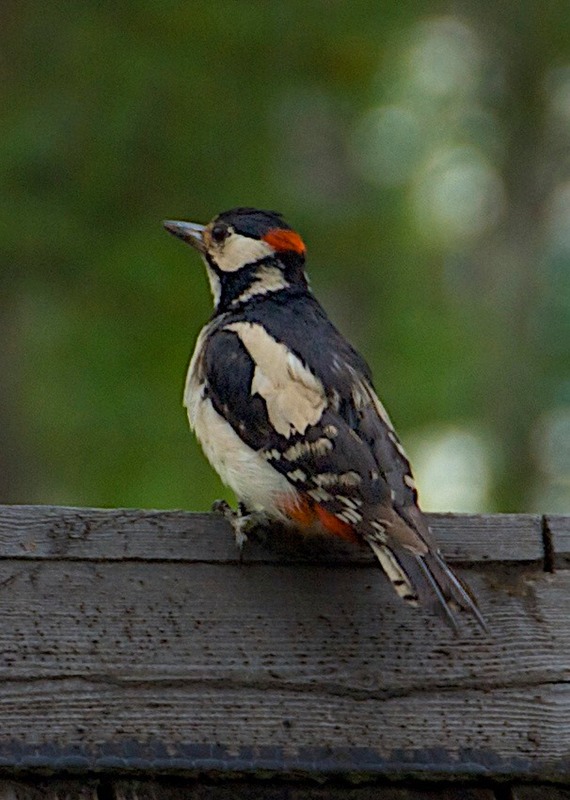
Having completed our Arctic Circle project, at least for this year (or so we thought), we drove on into Rovaniemi, finding ourselves in an actual “city” for the first time in weeks. We even had to pay to use a parking space. But it was nice to shop in a large store, and to walk streets that had red and green traffic lights. We even had lunch at McDonalds – the northernmost one in the world; bet you’ll want to add that one to your bucket list. Rovaniemi isn’t that large, but it calls itself the Capital of Lapland, and it is trying very hard to become cosmopolitan and very European. That’s hard, this far north, but they do pretty well at it, with outside cafes, music, pedestrianized streets, etc. Wonder how all this looks underneath a zillion feet of snow all winter – well, the total darkness probably helps.
Rovaniemi has a very cool library, and we used it several times over the couple of days we were hanging around. It was designed by Alvar Aalto, the famous Finnish architect, and is lovely and delightful to visit. (We are looking forward to seeing more of his works in the Helsinki area.) In addition, it has a Lapland Department, housing the world’s largest collection of Sámi literature, and is the country’s research center on all things Sámi. It was an amazing place. The city has a university, and is quite youthful in appearance. A side note: the graffiti in the women’s restroom was almost all in English – go figure.
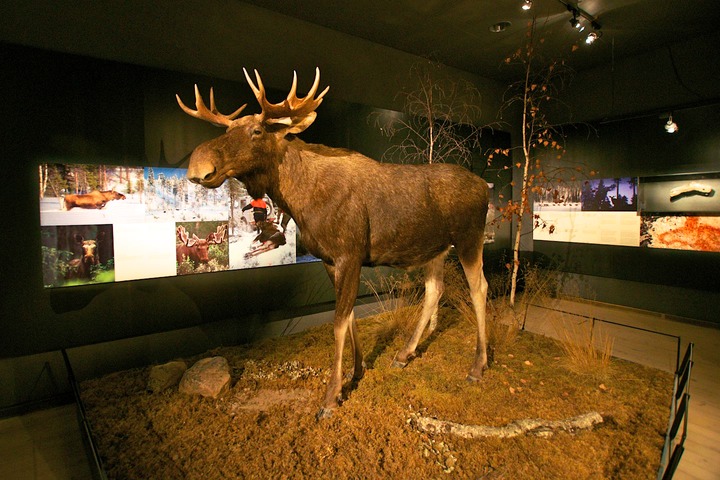
Our last stop before leaving town was at the Arktikum, the Lapland Museum and Arctic Science Center. We had waffled about visiting it, not being sure it was worth the effort. Ultimately we should have given it a pass. We had seen so many great things in other fine museums; this one was disappointingly routine and ordinary. They did have a lot of excellent photography on display, but little information to go with it. As a result, the pictures were both the strength and weakness of the museum. Maybe we’re just spoiled, and most certainly the Siida Museum in Inari is a very hard act to follow. They did have a really cool moose though, the only one we’ve seen all summer.
As we left this area, we realized we were saying good-by to the far north for this year. That made us sad, as we really like it up here (only in the summertime, of course!).
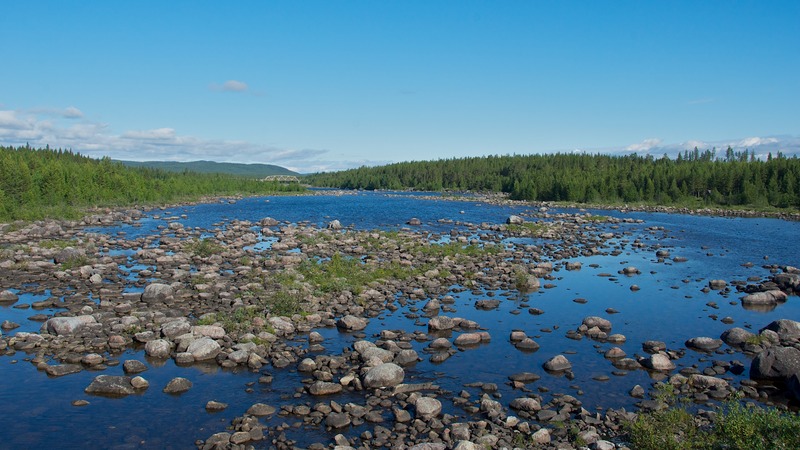
Heading toward Sweden, we spent a last couple of days parked beside a small lake not far from the border, where we enjoyed watching the local fishermen and basking in the warm sunshine. It was 73 degrees and it was mid-July. We really had enjoyed Finland. How can you not love a country that erects shelters and builds campfire spots – and even supplies free firewood -- along the shores of their lakes and streams?
We could have stayed forever. But we had mail waiting for us in Luleå, Sweden, about 90 miles away, following around the top of the Gulf of Bothnia. And plans to see northern and central Sweden, followed by a visit to Stockholm. So we had to go. But we will be back. When we leave Stockholm, we’ll take a ferry across the Gulf of Bothnia to Helsinki, and explore the parts of Finland we’ve not yet seen.
So we slipped across the border, tracked down the post office in Luleå, and – wonder of wonders – our mail was waiting for us! We shouldn’t be so doubtful; the international mail service has worked very well for us – almost always. But we will never forget (nor forgive) Italy and its bizarre refusal to deliver several packages to us, instead returning them to their place of origin. It was so maddening!
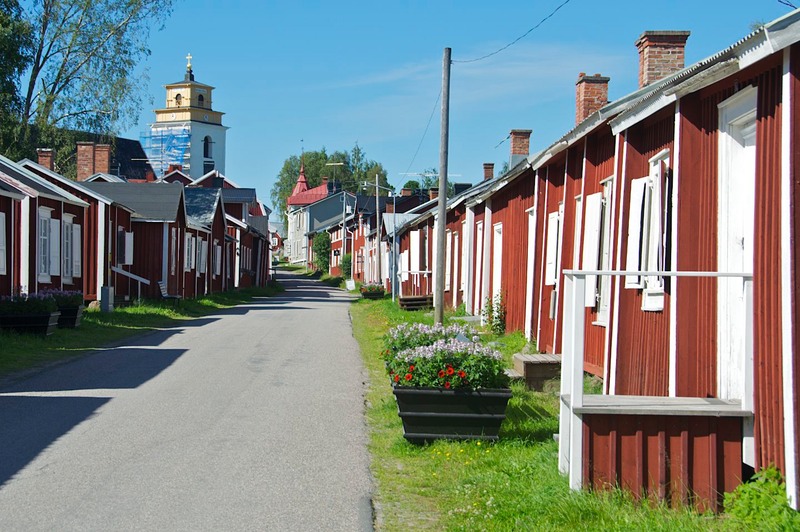
While we were in Luleå we looked for a library in order to get on-line. Trying to stay out of the center of this rather large city, we let Emily take us to a branch library. The librarian welcomed us with open arms; she’d never had anyone ask for wireless internet service before and while she knew they had it she had to call for help in order to get us the password. She was so charming and helpful we all had a lot of fun. Libraries in out-of-the-way places often have odd hours, and we had to wait until it opened, so walked around the corner for an ice cream. And they acted like they’d never seen any foreigners before! Such excitement, and coming out to look at the truck, and “What are you doing here?” (…at the ends of the earth). We decided this was one city that didn’t get a lot of tourists.
Aside from the mail, another reason we’d come through Luleå was to visit the community of Gammelstad, which was nearby. Gammelstad is the largest extant “church town” in Sweden and a UNESCO site. Church villages in Scandinavia go back in history to times when it was very difficult for parish members to get into town for services and special events. They lived in remote villages where their daily routine was all-enveloping. Church weekends and festivals were their getaway. Simple housing was built near the church so they could stay overnight or longer. Gammelstad possesses the largest such community in Sweden, with over 400 cottages. It surrounds a very nice medieval church, and sits in the bucolic countryside. It makes a very pleasant modern day visit, and we enjoyed the horses in the fields, up to their hocks in wildflowers and grass. We have seen other such communities up here in the north, but this was the largest by far.
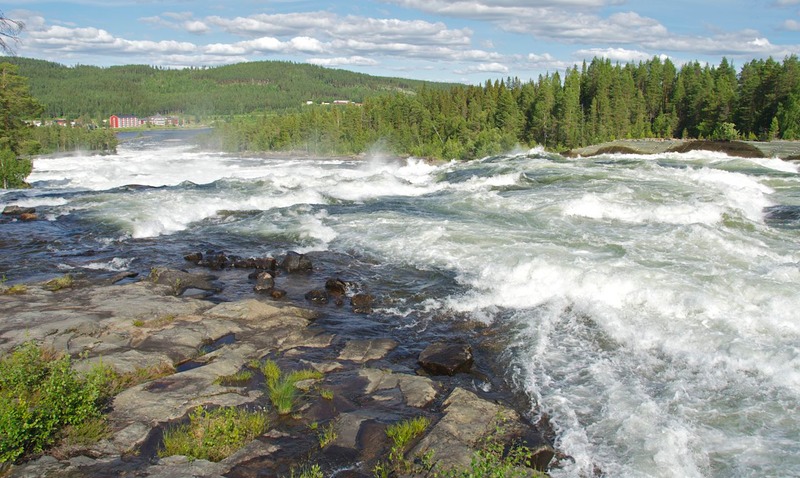
Leaving Gammelstad, we intended to head south, toward Stockholm. We had two choices of route – down the coast or down through the interior. Well, the coast route would be faster but we thought the interior route might be more scenic. As often happens, fate intervened and the decision was made for us. We stopped at the nearby town of Piteå, which we knew had one of the few propane stations in the country (there are none in Finland). While we were filling up, we met Jonas Lundgren, a motorcyclist on a KTM who stopped to chat with Rick. He ended up telling us about a very pretty waterfall, Storforsen Falls, that we could go see, inland, and a nice route to check out a bit of the country. Well, that was all we needed. We visited the waterfall (really amazing, actually), which was full of picnics and swimming underway, loads of folks out enjoying themselves among the trees.
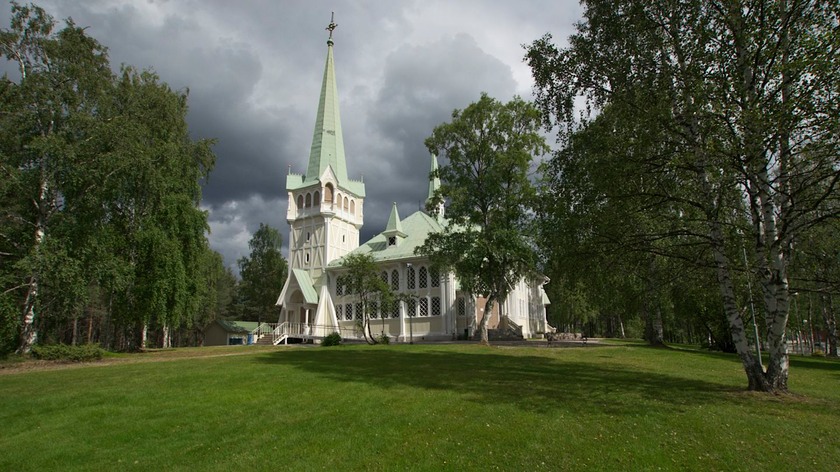
This was great, but I was starting to get a bee in my bonnet. For quite awhile, I’d been wanting to visit Jokkmokk (more about that in a minute). We’d decided not to since it meant a turn back north, but the trip to the falls took us nearly half way there and we were now seeing road signs marking the direction.So after the briefest of chats we kept on going north, up into the woods and deeper into Sámi country once again. We’d been on the edges all along; Sámi lands extend considerably south of where we were. We started seeing reindeer again. That was cool; we’d been afraid they were a thing of the past and had been going through withdrawal as the far north dropped further behind us.
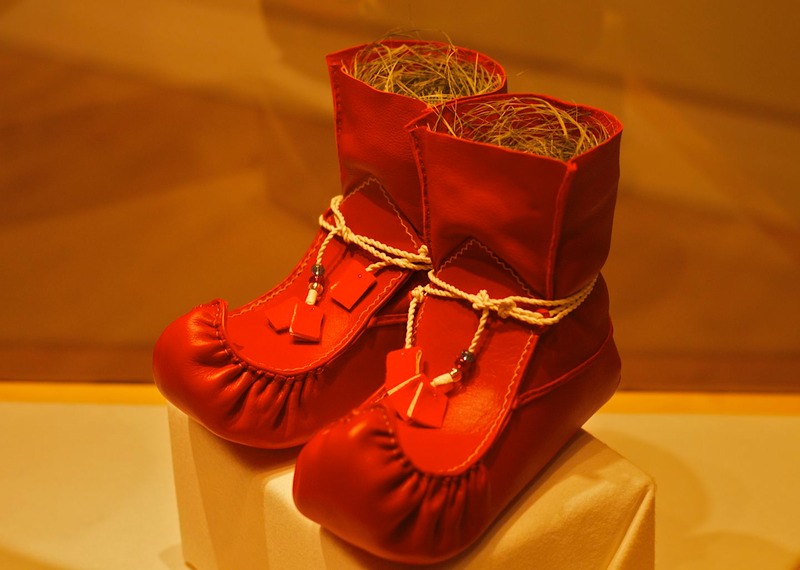
We stopped at the Arctic Circle a little ways south of Jokkmokk, for a quiet communing with the commemorative signs (our fourth crossing of the summer in case you’re not keeping up), then pressed on 4 miles further and on into town. It’s a lovely, tidy place, and we enjoyed it, not the least because of its pretty church.And then we got to the museum that was the reason why we had come.
So, about Jokkmokk. It’s Sámi headquarters in northern Sweden, and has a really marvelous museum and education center, the Atjje Museum. We both loved it. We spent hours wandering through, learning about reindeer herding techniques, how to identify the differences in clothing worn in various parts of Lapland, and about life in the Swedish mountains. There were wonderful bird exhibits, miniature carvings of daily life in the mountains, stuffed animals, discussions of shamanism, whatever you wanted to know. Jokkmokk, by the way, means “bend in the river.” The area had long been a gathering place for trading, festivals, etc. A great spot and we’re really glad we came.
So now we were really inland, and starting south down the spine of Sweden. Highway E45 it’s called – the Inlandsvägen. The E45 actually goes all the way from the Swedish-Norwegian border down to Sicily; that’s quite a trek. Logging trucks were bustling about, and there were plenty of wildflowers. The forest was quite attractive, partly because of the boggy ground cover, and partly because much of this was managed forest and the trees had been thinned out, leaving spaces between them. There were homes among the trees, and clustered around the small towns. The E45 often parallels the Inlandsbanen, the railroad that runs from the Lake Siljan area up to the top of Sweden and which is a great touristing opportunity. The air was clear and the clouds were white – seemingly no air pollution at all. Not too shabby.
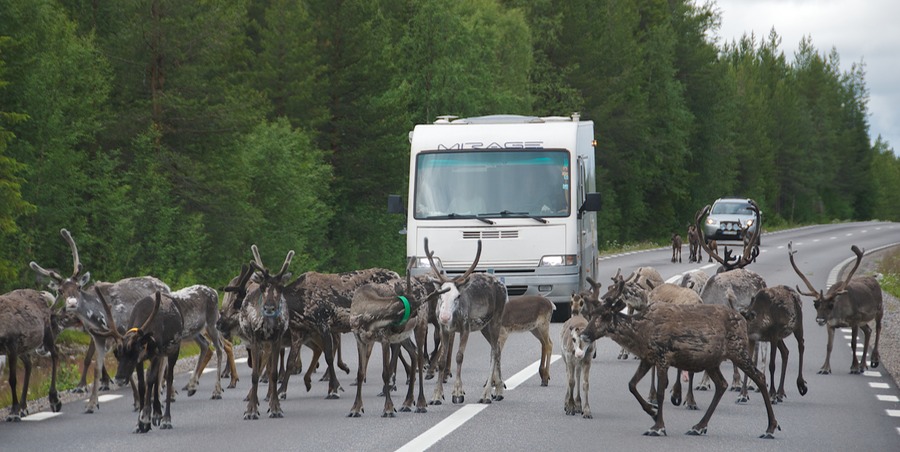
They’ll tell you that north of Stockholm Sweden is all forest. Well, not actually, although it might seem like it. Coming down E45, we passed through charming small villages, areas of open pasture, and regional centers that suddenly seemed quite cosmopolitan in comparison. We paused in the town of Sorsele, home of the Inlandsbanen Railroad Museum, quite interesting. It was a small museum, but had some really neat old pictures and stuff; well worth a visit. Sorsele is a resort town, and had a nice library for internet, which was typical – we’ve had very good luck getting on line in Lapland. It had rained off and on much of the day. Didn’t dampen our spirits though, nor those of the zillion mosquitoes accompanying us on our journey through the hinterland.
We spent a night up a little road into the ski area above the town of Storuman; lots of ski areas in these mountains. We crossed the Vojman River, with its giant fishing rod and huge model of a salmon jumping out of the river. Fishing country. We started feeling like life was just a little too civilized, too soon. We needed to get off into the back country again. Rick dug out some information we had on something called the Vildmarksvägen, The Wilderness Road. It would take us further west, on a loop that went smack up against the Norwegian border, up into the Stekenjokkplatån (a high plateau) and its remote areas. We give lip service to cutting back on mileage to save money, but in the end we are wanderers at heart and nearly always give in to the call of a new and unseen road.
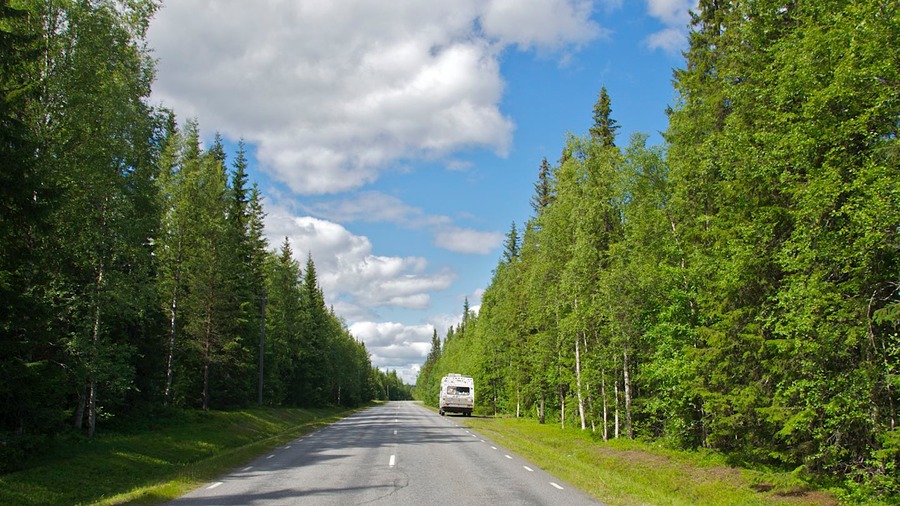
We stopped at the tourist information office in Vilhelmina, not much further along. They were quite enthusiastic about the road, and gave us some info on things to see along the way, including several waterfalls and historic sites. All in all, a good plan. So off we went. We were immediately delighted with the remoteness of our road, the lack of commercialism, and our return to the empty spaces we’d been enjoying for so long. We spent 3 days wandering along this loop, with the mountains of Norway always close at hand, finding some of the recommended “attractions” but mostly appreciating the barren, isolated, still-snowy countryside. It was higher in altitude, and we knew it at night, running the heater and throwing on an extra blanket yet again.
Our stop in Fatmomakke, a Sámi church village from the 1800s, was interesting in that it showed them completely integrated into the larger community of a religious settlement. There was “regular” housing as well as traditional huts, storage platforms, etc. And it was in a lovely setting alongside a lake.
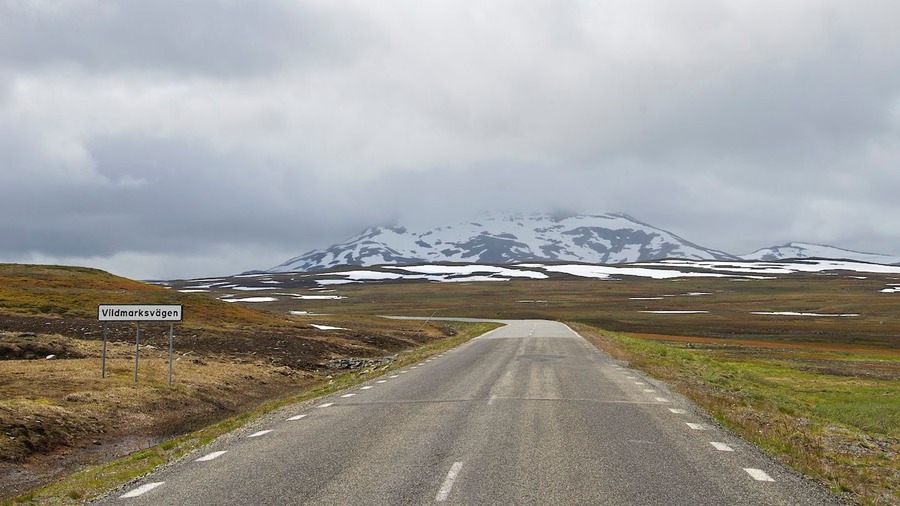
At our westernmost point we left the banks of the Kultsjön River and headed above tree line and into the Stekenjokk Plateau. It was 876 meters at the top, quite barren but with some green ground cover. There were other cars around, with folks out hiking. We saw a group of reindeer in the distance, munching on the green stuff; they were quite shy, and kept their distance from the little children trying to get close. We paralleled the border as we turned south, passing more reindeer and a few small Sámi communities. Eventually turning east again, we passed through more developed communities, even though this was major brown bear habitat. (Saw nary an example and refused to go to the park where you could “view” them.) Guess the bears keep to themselves.
We enjoyed this trip very much, following rivers and hiking (oh, don’t look so surprised) to get to waterfalls, the rapids falling through rugged gorges and between huge rocks. Every small lake had its little hamlets, really just a cluster of old (sometimes dilapidated) houses, each with its simple, attractive church and separate bell tower. We saw more and more wildflowers as we returned to lower elevations, including the amazing lupine-relatives that are so showy and dramatic.
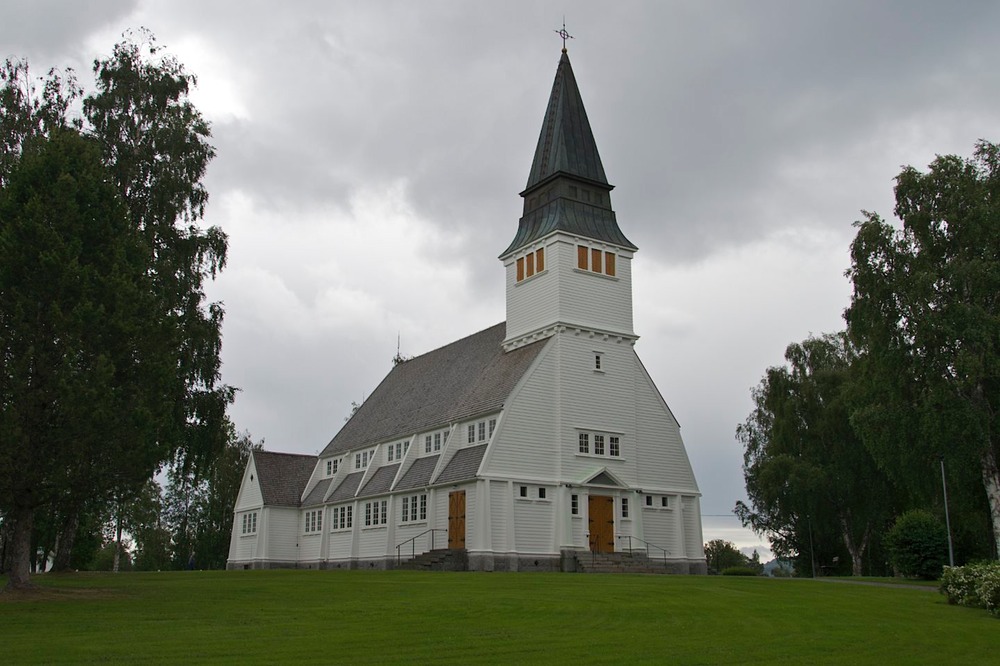
As lunchtime was approaching one day we saw a really pretty church across the water and went to see if we could find it. The town turned out to be Alanäs and the church was probably the prettiest wooden church we’ve yet seen; really nice. We took some photos and had lunch in the parking lot before moving on again.
We spent one last night in seclusion amongst a field of purple and white clover, then all too suddenly we reached Strömsund, back at the E45. It all looked quite civilized. Hmmm, too civilized – trailers & RV parks, huge statues of bears just waiting to be photographed (“The Largest Wooden Bear in the World”), Loppis everywhere (that’s Swedish for flea market/second hand store), you get the picture.
We stayed on the E45 for about 2 minutes and then found something smaller, more remote to take instead. We knew we needed to keep moving south, with “Time’s A-wasting” ringing in our ears. But we wanted to hold that “Lapland” experience in our heads just as long as possible.
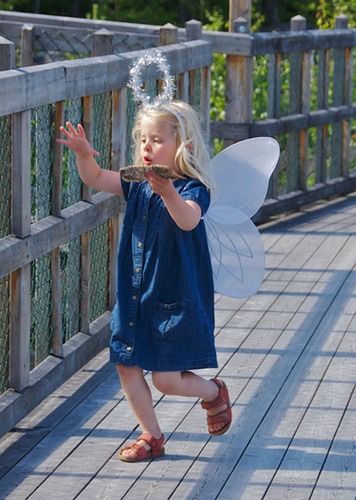
Our 3 days on the Vildmarksvägen constituted our last wilderness time in Sweden. We saw our last reindeer and our southernnmost Sámi communities, and that was sad. We were doubly glad we’d taken the time. It helped us cement our excellent memories of this very different area that we’d enjoyed in three different countries: Norway, Sweden and Finland. We’d learned a lot, but even more we’d been able to really get out and see places that were at least faintly similar to the way they’d been hundreds of years ago. The 21st century hasn’t left Lapland behind, but the people who live there have been able to retain a lot of “the way it’s always been.” Lapland is a very different part of the world from “mainstream” Scandinavia, and still has a different sensibility. We liked that a lot.
But civilization was calling us. We had plans for Stockholm, followed by a ferry across the Gulf of Bothnia to see southern Finland. Then the Baltics – there’s a lot more summer ahead of us. August is just beginning! So stay with us; more, after a brief intermission.
Hugs from all of us – Rick, Kathy and La Tortuga – now visiting our 41st country!
Click to see more photos from Northern Finland & Sweden